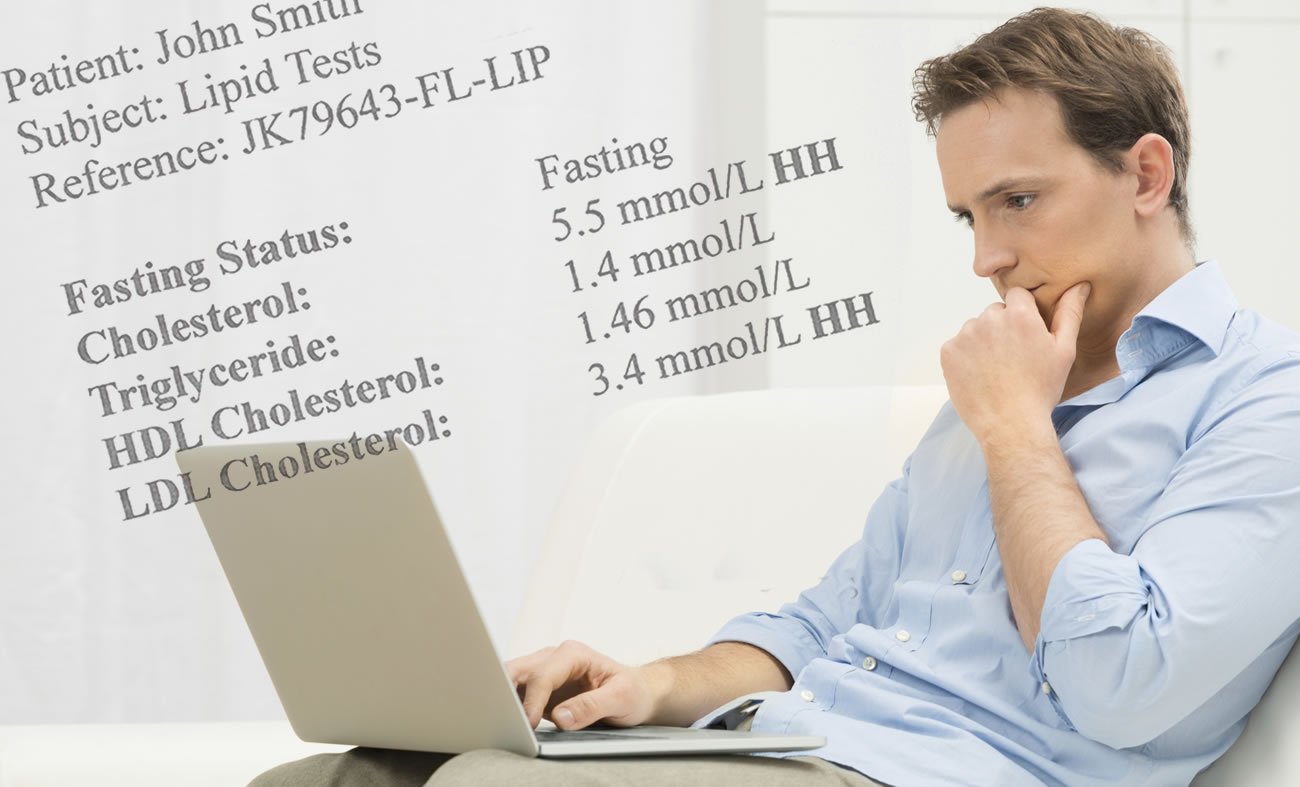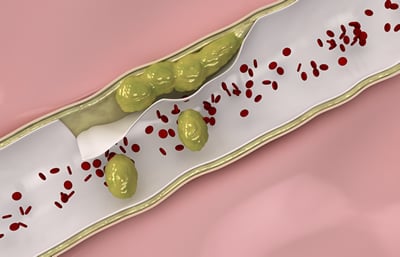What do my cholesterol results mean?
We call heart disease the silent killer. Many people usually feel fine the day before a heart attack or stroke, but they are really a coronary time bomb. Did you know that 85% of 50-year-old people in America have blockages in their arteries without any symptoms? It really is a tragedy that risk factors like high cholesterol are not painful until it is too late.
In this article, we’ll discuss the most important things you can do to avoid a heart attack, as well as optimal levels for LDL (bad) cholesterol, total cholesterol, HDL (good) cholesterol, and triglycerides.

What do my cholesterol results mean? What should I aim for?
To understand your cholesterol numbers, it’s a good idea to understand, first of all, what cholesterol is.
Cholesterol is a complex molecule found in all animals, including humans. It’s vital for a number of reasons. It makes hormones and cell membranes and carries out numerous cell functions. We would not exist without cholesterol, but then again, neither would plaque build-up and heart disease.
Our body, particularly our liver, manufactures all the cholesterol we need. We do not need any more from the food we eat.
Eating foods high in cholesterol, saturated fat, and trans fats can very easily raise levels of cholesterol in our blood. It’s this extra cholesterol that can cause a world of hurt in our arteries.
How does cholesterol cause a heart attack?
Bad forms of cholesterol seep into the inner walls of the arteries, creating plaque. Like sores on your skin, plaques are raw, sensitive to infection, which means they make the inside skin of the arteries a breeding ground for inflammation.

The higher our blood levels of bad cholesterol, the more plaques tend to form, and the more inflamed the arterial skin becomes.
Plaque build-up is also known as atherosclerosis.
Plaque that ruptures
Most heart attacks occur because one of these plaques ruptures. Like boils, many plaques are soft and fragile, full of cholesterol-rich “pus.” When inflamed, they can burst and spew their contents into the bloodstream.
This eruption triggers chemical reactions that often culminate with a large blood clot, which can choke off blood flow to the heart, causing a heart attack.
Scientists call a plaque that has burst or ruptured the single most common lethal event of the industrialized world.
Plaque build-up can happen in arteries throughout the body, including those carrying blood to the brain, which means that plaque rupture causes not only heart attacks but also strokes and other circulatory problems.
Can I stabilize these plaques?
Yes. That’s the really good news. With a healthy lifestyle and, if needed, cholesterol-lowering medications, you can stabilize plaques and improve the entire health of the inner walls of your arteries.
 Lowering cholesterol levels will help you stabilize the plaque in your arteries’ walls.
Lowering cholesterol levels will help you stabilize the plaque in your arteries’ walls.
Recommended Values For Non-HDL Cholesterol:
Less than 100 if you’re healthy.
Less than 80 if you have coronary artery disease.
Key lifestyle actions to lower non-HDL and LDL cholesterol:
- Eat far fewer saturated fats (such as butter, palm oil, coconut oil, meat fats, and milk fats); trans fats (any foods that have partially hydrogenated oils in their ingredient lists); and dietary cholesterol. Food high in dietary cholesterol include egg yolks and organ meats.
- Eat far more fiber-rich foods (especially soluble fiber from beans, yams, oats, barley, and berries, or BYOBB).
- Eat vegetable proteins (such as tofu and beans) in place of meat and poultry.
- Eat fewer refined sugars (especially fructose) and refined grains (such as white flour).
- Exercise regularly: 1) Aerobic exercise daily, a minimum of 30 minutes and optimally 60 to 90 minutes, alternating moderate-intensity days with vigorous-intensity days; 2) Full-body resistance routine two to three times weekly; and 3) Stretching exercises daily to greatly enhance your overall flexibility and ability to exercise more freely.
- Lose excess weight, especially weight around the middle.*
- If the above are insufficient, try plant sterols (such as CholestOff)
- If necessary, talk to your doctor about medications.
* Excess body weight is defined as a BMI (Body Mass Index) greater than 25. More important is improving your body composition (muscle-to-fat ratio) and reducing abdominal girth. Of particular concern are men who are more than 40″ around the waist and women who are more than 35.” Belly fat and a poor body composition are key contributing factors for not only elevated cholesterol but also diabetes, hypertension, and other cardiovascular-related diseases.
HDL Cholesterol
Is HDL still thought of as the “good” cholesterol?
Yes and no.
We once thought HDL was always “good,” and the more HDL in the blood, the better.
Dysfunctional HDL
But we now know that HDLs can lose their ability to reduce inflammation and act as good “garbage trucks,” removing cholesterol from the artery wall.
Bottom Line: There is HDL that is functioning well and doing good things for our arteries, but there is also HDL that is dysfunctional.
How to repair HDL
The good news: Research is now finding that a healthy lifestyle can help repair HDL. Scientists at UCLA, for example, followed men attending the Pritikin Longevity Center and found that at entry, the men tended to have dysfunctional HDL. But after three weeks at Pritikin, blood tests showed that their HDL had converted from pro-inflammatory to anti-inflammatory. Dysfunctional HDL, in other words, had returned to well-functioning HDL.
Lowest heart disease rates in the world
Moreover, don’t be overly concerned if you’re following a heart-healthy lifestyle like Pritikin but your HDL is lower than traditionally recommended ranges (greater than 50 or 60). Over the last four decades, studies have consistently found that populations with some of the lowest heart disease rates in the world, such as the people of Okinawa, Japan, had very low levels of HDL, in the 20s and 30s.
Studying rural Chinese populations in the 1990s, Dr. Colin Campbell of Cornell University found that their death rates from heart disease were 94% lower than that of American men. Their HDL cholesterol was about 30. Yes, very low HDL, but very good heart health.
The diet of these rural Chinese? Like the Pritikin Eating Plan, it was rich in vegetables, fruits, and other whole, unprocessed plant foods – and had three times more fiber than a typical American diet.
Indeed, HDL levels tend to go down a little when people first start the Pritikin Program. But, as discussed earlier, the functionality of HDL appears to improve significantly.
Bottom Line: While high HDL cholesterol levels may often be desirable, low non-HDL levels are even more desirable.
Recommended Value For HDL Cholesterol:
Above 40, but lower levels do not appear problematic if you’re following a heart-healthy lifestyle like Pritikin and if your non-HDL level is healthy.
Key lifestyle actions to raise HDL (the well-functioning form of HDL):
- Exercise regularly: 1) Aerobic exercise daily, a minimum of 30 minutes and optimally 60 to 90 minutes, alternating moderate-intensity days with vigorous-intensity days; 2) Full-body resistance routine two to three times weekly; and 3) Stretching exercises daily to greatly enhance your overall flexibility and ability to exercise more freely.
- Lose excess weight.
- Stop smoking.
- Eat fewer trans fats (preferably none).
- Drink alcohol in moderation. For women, no more than 4 drinks weekly (not more than 1/2 to 1 drink per day). For men, no more than 7 drinks weekly (not more than 1 to 2 drinks per day).
Unfortunately, no medication has been shown to significantly and safely raise HDL. Lifestyle improvements appear more effective.
Recommended Value For Triglycerides:
Less than 150, ideally less than 100.